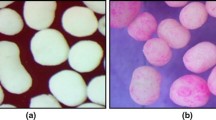Abstract
The aim of this study was to investigate the influence of different processing methods on the profiles of 5-aminosalicylic acid dissolution from controlled-release matrix systems based on Eudragit® RL and Eudragit® RS water-insoluble polymers. The pure polymers and their mixtures were studied as matrix formers using different processing methods, i.e., direct compression, wet granulation of the active ingredient with the addition of polymer(s) to the external phase, wet granulation with water, and wet granulation with aqueous dispersions. In comparison with the directly compressed tablets, tablets made by wet granulation with water demonstrated a 6–19% increase in final drug dissolution, whereas when polymers were applied in the external phase during compression, a 0–13% decrease was observed in the amount of drug released. Wet granulation with aqueous polymer dispersions delayed the release of the drug; this was especially marked (a 54–56% decrease in drug release) in compositions, which contained a high amount of Eudragit RL 30D. The release profiles were mostly described by the Korsmeyer–Peppas model or the Hopfenberg model.








Similar content being viewed by others
Abbreviations
- E RS:
-
Eudragit® RS
- E RL:
-
Eudragit® RL
- 5-ASA:
-
5-Aminosalicylic acid
- E RL 30D:
-
Eudragit® RL 30D aqueous dispersion
- E RS 30D:
-
Eudragit® RS 30D aqueous dispersion
- DC:
-
Direct compression
- S 12 :
-
Spreading coefficient
REFERENCES
Verma RK, Krishna DM, Garg S. Formulation aspects in the development of osmotically controlled oral drug delivery systems. J Control Release. 2002;79:7–27.
Chang RK, Hsiao C. EUDRAGIT® RL and RS pseudolatices: properties and performance in pharmaceutical coating as a controlled release membrane for theophylline pellets. Drug Dev Ind Pharm. 1989;15(2):187–96.
Gillian CA, Wan PAL. Factors affecting drug release from a pellet system coated with an aqueous colloidal dispersion. Int J Pharm. 1991;73:51–68.
Lee L. Diffusion-controlled matrix systems. In: Kydonicus A, editor. Treatise on controlled drug delivery. New York: Marcel Dekker; 1992. p. 115–98.
Narasimhan B, Langer R. Zero-order release of micro and macromolecules from polymeric devices: the role of the burst effect. J Control Release. 1997;47:13–20.
Conte U, Maggi M. A flexible technology for the linear, pulsatile and delayed release of drugs, allowing for easy accommodation of difficult in vitro targets. J Control Release. 2000;64:263–8.
Peppas NA, Sahlin JJ. A simple equation for the description of the solute release: III. Coupling of diffusion and relaxation. Int J Pharm. 1989;57:169–72.
Talukder R, Fassihi R. Gastroretentive delivery systems: a mini review. Drug Dev Ind Pharm. 2004;30(10):1019–28.
Azarmi S, Ghaffari F, Löbenberg R, Nokhodchi A. Mechanistic evaluation of the effect of thermal-treating on Eudragit RS matrices. Il Farmaco. 2005;60:11–2.
European Pharmacopoeia 2.9.3 Dissolution test for solid dosage forms 01/2012:20903
USP NF 35, Physical tests <711> dissolution
FIP Guidelines for Dissolution Testing of Solid Oral Products. 1997. http://www.fip.org/www/uploads/database_file.php?id=260&table_id=. Accessed 30 Apr 2012.
Rowe RC, Sheskey PJ, Owen SC. Handbook of pharmaceutical excipients. 5th ed. Washington: Pharmaceutical Press and American Pharmacists Association; 2006.
Kállai N, Luhn O, Dredán J, Kovács K, Lengyel M, Antal I. Evaluation of drug release from coated pellets based on isomalt, sugar, and microcrystalline cellulose inert cores. AAPS PharmSciTech. 2010;11(1):383–91.
The Merck Manual Online http://www.merckmanuals.com/professional/gastrointestinal_disorders/inflammatory_bowel_disease_ibd/crohns_disease.html. Accessed 28 Apr 2012.
Peppercorn MA, Goldman P. Distribution studies of salicylazosulfapyridine and its metabolites. Gastroenterology. 1973;64:240–5.
Nielsen OH, Bondesen S. Kinetics of 5-aminosalicylic acid after jejunal instillation in man. Br J Clin Pharmacol. 1983;16:738–40.
Schröder H, Campbell DES. Absorption, metabolism and excretion of salicylazosulfapyridine in man. Clin Pharmacol Ther. 1972;13:539–51.
Friend DR. Colon-specific drug delivery. Adv Drug Deliv Rev. 1991;7(1):149–99.
Aulton ME. Aulton’s pharmaceutics. The design and manufacture of medicines. Edinburgh: Churchill Livingstone, Elsevier; 2007.
Rowe RC. Binder–substrate interactions in granulation: a theoretical approach based on surface free energy and polarity. Int J Pharm. 1989;52:149–54.
Parfitt GD. Dispersion of powders in liquids. New York: Wiley; 1973.
Peppas NA. Analysis of Fickian and non-Fickian drug release from polymers. Pharm Acta Helv. 1985;60:110–1.
Crank J. The mathematics of diffusion. Oxford: Clarendon; 1975.
Costa P, Lobo JMS. Modeling and comparison of dissolution profiles. Eur J Pharm Sci. 2001;13(2):123–33.
Hopfenberg HB. Controlled release polymeric formulations. In: Paul DR, Haris FW, editors. ACS Symposium Series, vol. 33. Washington: American Chemical Society; 1976. p. 26–31.
ACKNOWLEDGMENTS
The Project named “TÁMOP-4.2.1/B-09/1/KONV-2010-0005—Creating the Center of Excellence at the University of Szeged” is supported by the European Union and co-financed by the European Social Fund.
Disclosure Statement
Authors reported no conflict of interest.
Author information
Authors and Affiliations
Corresponding author
Rights and permissions
About this article
Cite this article
Korbely, A., Kelemen, A., Kása, P. et al. Effects of Processing on the Release Profiles of Matrix Systems Containing 5-Aminosalicylic Acid. AAPS PharmSciTech 13, 1341–1347 (2012). https://doi.org/10.1208/s12249-012-9861-9
Received:
Accepted:
Published:
Issue Date:
DOI: https://doi.org/10.1208/s12249-012-9861-9




